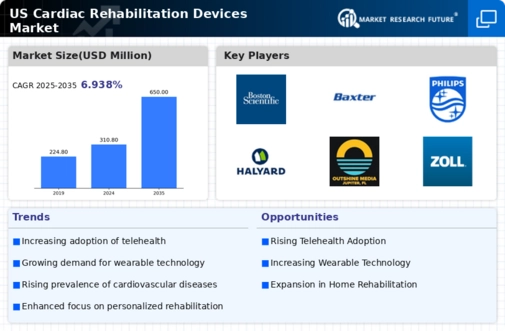Government Initiatives and Funding
Government initiatives aimed at improving cardiovascular health are significantly influencing the cardiac rehabilitation-devices market. Programs designed to promote awareness and access to rehabilitation services are gaining traction, with federal and state funding allocated to support these efforts. For instance, the Centers for Medicare & Medicaid Services (CMS) has expanded coverage for cardiac rehabilitation services, which is expected to increase patient participation. This financial backing not only encourages healthcare providers to invest in advanced rehabilitation devices but also enhances accessibility for patients. As a result, the cardiac rehabilitation-devices market is poised for growth, with projections indicating a potential increase in market size as more patients are referred to rehabilitation programs.
Aging Population and Increased Healthcare Needs
The aging population in the US is a significant driver of the cardiac rehabilitation-devices market. As individuals age, the risk of developing cardiovascular diseases escalates, leading to a higher demand for rehabilitation services. The US Census Bureau projects that by 2030, all baby boomers will be over 65 years old, resulting in a substantial increase in the elderly population. This demographic shift is likely to create a greater need for cardiac rehabilitation, as older adults often require specialized care to recover from heart-related events. Consequently, the cardiac rehabilitation-devices market is expected to grow, as healthcare providers seek to equip themselves with the necessary devices to cater to this expanding patient population.
Increasing Prevalence of Cardiovascular Diseases
The rising incidence of cardiovascular diseases in the US is a primary driver for the cardiac rehabilitation-devices market. According to the American Heart Association, cardiovascular diseases account for approximately 697,000 deaths annually, representing about 1 in every 5 deaths. This alarming statistic underscores the urgent need for effective rehabilitation solutions. As healthcare providers increasingly recognize the importance of rehabilitation in improving patient outcomes, the demand for specialized devices is expected to grow. The cardiac rehabilitation-devices market is projected to expand as more patients seek rehabilitation services post-heart events, leading to a potential increase in market value. Furthermore, the integration of these devices into standard care protocols may enhance recovery rates, thereby driving further adoption and innovation in the market.
Technological Innovations in Rehabilitation Devices
Technological advancements play a crucial role in shaping the cardiac rehabilitation-devices market. Innovations such as wearable devices, telehealth solutions, and mobile applications are transforming how rehabilitation is delivered. These technologies enable real-time monitoring of patients' progress, allowing healthcare providers to tailor rehabilitation programs to individual needs. The market is witnessing a surge in demand for devices that incorporate artificial intelligence and machine learning to enhance patient engagement and adherence. As a result, the cardiac rehabilitation-devices market is likely to experience significant growth, with estimates suggesting a compound annual growth rate (CAGR) of around 8% over the next few years. This trend indicates a shift towards more personalized and efficient rehabilitation solutions, ultimately improving patient outcomes.
Growing Awareness of Cardiac Rehabilitation Benefits
There is a growing awareness among patients and healthcare professionals regarding the benefits of cardiac rehabilitation, which is driving the cardiac rehabilitation-devices market. Educational campaigns and outreach programs have highlighted the positive impact of rehabilitation on recovery and long-term health outcomes. Studies indicate that participation in cardiac rehabilitation can reduce mortality rates by up to 30% and improve quality of life. This heightened awareness is likely to lead to increased referrals to rehabilitation programs, subsequently boosting the demand for specialized devices. As healthcare systems prioritize preventive care and chronic disease management, the cardiac rehabilitation-devices market is expected to expand, reflecting the increasing recognition of rehabilitation's role in comprehensive cardiovascular care.

















Leave a Comment